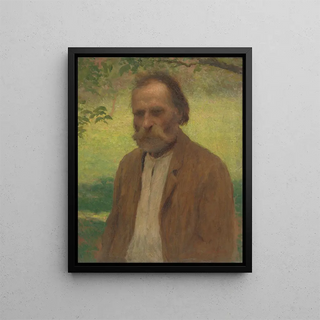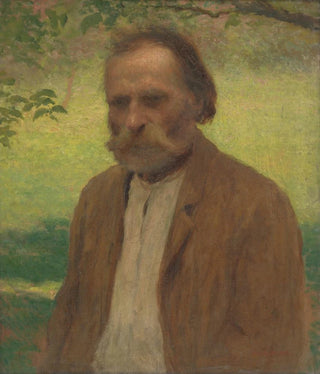Art print Old man outdoors - Elemér Halász-Hradil


View from behind

Frame (optional)
In the rich and complex universe of art, some works manage to capture the very essence of humanity with striking delicacy. "Old Man Outdoors" by Elemér Halász-Hradil is one of these creations that, through its soothing atmosphere and introspective gaze, transports the viewer into a world where time seems to stand still. This painting, imbued with melancholy and wisdom, evokes the beauty of simple moments—those we often forget amid the tumult of modern life. The artist succeeds in evoking a deep connection between the subject and the surrounding landscape, inviting each viewer to reflect on the passage of time and the richness of memories.
Style and uniqueness of the work
Halász-Hradil's style is distinguished by a naturalistic approach, where light and color play a crucial role in visual storytelling. In "Old Man Outdoors," delicate shades of green, brown, and ochre create a harmony that envelops the subject with palpable softness. The artist uses subtle brushstrokes to render the texture of the old man's skin, while the background, though blurred, suggests a vibrant natural environment. This work does not merely depict a character; it tells a story—the story of a man who, despite life's hardships, finds peace in contemplating his surroundings. The composition, balanced and thoughtful, guides the viewer's gaze toward the old man's face, where centuries of experience and reflection are visible.
The artist and his influence
Elemér Halász-Hradil is an artist whose work continues a pictorial tradition that celebrates the beauty of everyday life. Born in Hungary, he was influenced by European master painters, while developing a style that is uniquely his own. His ability to capture fleeting moments of life and immortalize transient emotions has made him a recognized and respected painter. Halász-Hradil has absorbed the artistic movements of his time, while remaining faithful to his personal vision. His work is often marked by deep introspection, a

Matte finish

View from behind

Frame (optional)
In the rich and complex universe of art, some works manage to capture the very essence of humanity with striking delicacy. "Old Man Outdoors" by Elemér Halász-Hradil is one of these creations that, through its soothing atmosphere and introspective gaze, transports the viewer into a world where time seems to stand still. This painting, imbued with melancholy and wisdom, evokes the beauty of simple moments—those we often forget amid the tumult of modern life. The artist succeeds in evoking a deep connection between the subject and the surrounding landscape, inviting each viewer to reflect on the passage of time and the richness of memories.
Style and uniqueness of the work
Halász-Hradil's style is distinguished by a naturalistic approach, where light and color play a crucial role in visual storytelling. In "Old Man Outdoors," delicate shades of green, brown, and ochre create a harmony that envelops the subject with palpable softness. The artist uses subtle brushstrokes to render the texture of the old man's skin, while the background, though blurred, suggests a vibrant natural environment. This work does not merely depict a character; it tells a story—the story of a man who, despite life's hardships, finds peace in contemplating his surroundings. The composition, balanced and thoughtful, guides the viewer's gaze toward the old man's face, where centuries of experience and reflection are visible.
The artist and his influence
Elemér Halász-Hradil is an artist whose work continues a pictorial tradition that celebrates the beauty of everyday life. Born in Hungary, he was influenced by European master painters, while developing a style that is uniquely his own. His ability to capture fleeting moments of life and immortalize transient emotions has made him a recognized and respected painter. Halász-Hradil has absorbed the artistic movements of his time, while remaining faithful to his personal vision. His work is often marked by deep introspection, a
12,34 €






